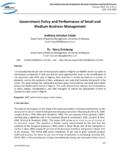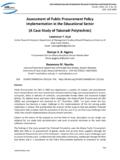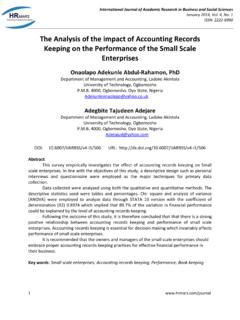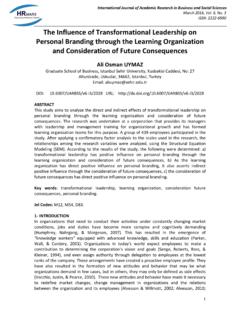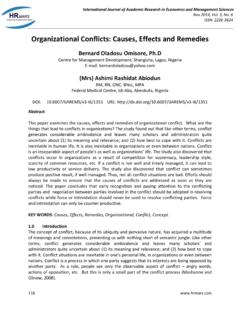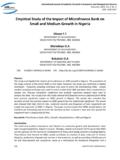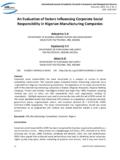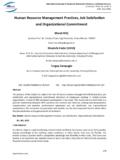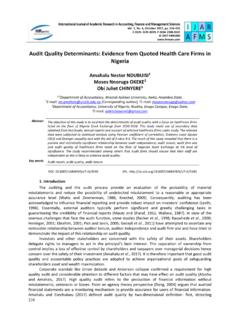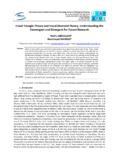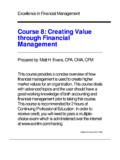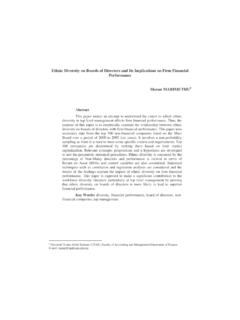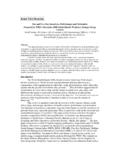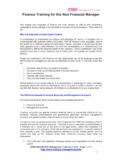Transcription of Effect of Financial Leverage on Financial …
1 180 International Journal of Academic Research in Accounting, Finance and Management Sciences Vol. 4, , April 2014, pp. 180 188 E-ISSN: 2225-8329, P-ISSN: 2308-0337 2014 HRMARS Effect of Financial Leverage on Financial Performance of Deposit Taking Savings and Credit Co-operative in Kenya Moses Ochieng GWEYI1 John KARANJA2 1 The Co-operative University, College of Kenya 1E-mail: 2 Jomo Kenyatta University of Agriculture and Technology, Kenya Abstract The aim of this study was an attempt to investigate the Effect of Financial Leverage on Financial performance of deposit taking Saccos in Kenya. The sample data was extracted from 40 Savings and Credit Co-operative Societies (Saccos) registered by Sacco Society Regulatory Authority (SASRA) extended from the period 2010 to 2012.
2 The secondary data used for analysis was collected from the Financial statements of the various deposit taking Saccos. Two basic approaches descriptive and analytical design were adopted. The results show perfect positive correlation between debt equity ratio with return on equity and profit after tax at 99% confidence interval and a weak positive correlation between debt equity ratio with return on assets and income growth. As the scope of study is limited to the deposit taking Saccos and the sample size is small, the findings of the study must be interpreted with caution and the results may not be generalized to the Sacco sector. This is the first study that examines the relationship between Financial Leverage on Financial performance of deposit taking savings and credit co-operative in Kenya.
3 Key words Financial Leverage , Financial Performance, Co-operatives, Saccos DOI: URL: 1. Introduction Background of the Study In the quest to optimize their objective, which hinges primarily on quantifiable performance, Financial managers have adopted various capital structures as a means to that goal. A firm can finance its investment by debt and/or equity. The use of fixed-charged funds, such as debt and preference capital along with the owner s equity in the capital structure is described as Financial Leverage or gearing (Dare and Sola, 2010). An unlevered firm is an all-equity firm, whereas a levered firm is made up of ownership equity and debt. Financial Leverage takes the form of a loan or other borrowing (debt), the proceeds of which are (re)invested with the intent to earn a greater rate of return than the cost of interest.
4 If the firm s marginal rate of return on asset (ROA) is higher than the rate of interest payable on the loan, then its overall return on equity (ROE) will be higher than if it did not borrow (Laurent, 2005). On the other hand, if the firm s return on assets (ROA) is lower than the interest rate, then its return on equity (ROE) will be lower than if it did not borrow. Leverage allows a greater potential returns to the investor than otherwise would have been available, but the potential loss is also greater: if the investment becomes worthless, the loan principal and all accrued interest on the loan still need to be repaid (Andy et al., 2002). This constitutes Financial risk (Pandey; 2005). The degree of this Financial risk is related to the firm s Financial structure.
5 The total combination of common equity, preferred stock and short and long term liabilities is referred to as Financial structure. That is, the manner in which the firm finances its assets constitutes its Financial structure. If short-term liabilities are subtracted from the firm s Financial structure, we obtain its capital structure. In other words, the firm s permanent or long-term financing consisting of common equity, preferred stock and long term debt is called capital structure International Journal of Academic Research in Accounting, Finance and Management Sciences Vol. 4 (2), pp. 180 188, 2014 HRMARS 181 (Van Horne, 2002). Hence, the objective of Financial management in structuring a firm s capital components is to maximize the shareholders wealth, as a measure of performance. Based on the above the problem of this study is to analyze the implications of Financial Leverage on performance.
6 Also considering that maximizing accounting profit and maximizing shareholders value are not identical because of shareholders losses from agency costs, it is therefore pertinent to see how capital structure affect shareholders value. Overview of Saccos in Kenya In 2007 the ICA ranked the Co-operative Sector in Kenya number seven in the world and one in Africa in terms of membership, capital, number of enterprises, and contribution to national economy. Today, Kenya has about 15,000 registered Co-operatives which can be broadly categorized as non- Financial and Financial Co-operatives. Non Financial co-operative include trading, produce and marketing Cooperatives. Financial Cooperatives include Savings and Credit Cooperatives (SACCO societies), Housing, Union of SACCOs, and Investment Co-operatives.
7 SACCO societies have significantly increased to account for 50% of the registered Co-operatives. The Kenya s national development blueprint and the Vision 2030 recognize SACCO societies as important players in deepening Financial access to mobilize savings for investments in enterprises and personal development (Mohammed, 2013). Sacco sub sector comprises both Deposit Taking and non-Deposit Taking Saccos. Non-Deposit Taking Saccos is supervised by the Commissioner for Co-operatives while Deposit Taking Saccos ( Saccos) are licensed and regulated by SASRA. SASRA licenses Saccos that have been duly registered under the Cooperative Societies Act CAP 490. As at December 2012 the total Sacco sub sector assets stood at Kshs. 293 billion and total membership for the sector was 3 million persons.
8 Total deposits for the sector stand at billion and Loans to members are at Kshs. 221 billion (Ademba, 2013). There are 6,151 registered Saccos out of the total twelve thousand (12,000) registered co operatives, which is about 51% of the total number of co-operatives in Kenya. Out of the 6,151 Sacco 165 are rural Saccos (commodity based) while the rest are Urban Saccos. All Saccos operate Back Office Service Activities and have been able to mobilize over Kshs 180 billion and granted loans to the tune of Kshs 120 billion. Out of the 6,151 Saccos 135 have ventured into front office service activities (FOSA). The FOSA offer bank-like services, like withdraw-able savings, debit cards, advances, deposits, money transfers etc. FOSA activity came about after banks withdrew from many rural areas and the people were left un-banked.
9 Various FOSAs have received Salary Codes from employers and their members salaries are paid through the FOSAs. The Saccos with FOSAs are spread all over the country and include both Rural and Urban Saccos. The Ministry of Co-operative Development and Marketing (MoCD&M) is responsible for the development of the Cooperative sector through policy and legal framework to facilitate attainment of the national social-economic goals in Kenya (Ademba, 2012). Unlike other commercial establishments, co-operatives are guided by the cooperative philosophy which is based on seven Co-operative Principles formulated by International Co-operative Alliance (ICA). The Sacco Societies Regulatory Authority (SASRA) is a creation of the Sacco Societies Act. The Authority s establishment falls within the broad Government of Kenya s reform process in the Financial sector which has the dual objectives of protecting the interests of Sacco members and ensuring public confidence towards the Sacco.
10 This ultimately will spur economic growth through deepening Financial access, mobilization of domestic savings and affordable credit to Sacco members (Ademba, 2013). Statement of the Problem A recent study by FSD (2013) revealed that Saccos are facing severe liquidity problems and majorities are unable to meet the demands of their clients for loans and withdrawal of savings. Given this situation, clients despite their loyalty are getting anxious about the future of the Saccos. If this situation is not rectified, we may witness the demise of Saccos which will be a terrible loss for Kenyans. There is need therefore, to understand the Effect external financing has on Financial performance of Saccos. The major problem areas facing Saccos include the following; Inadequate Legal and Regulatory frame work Saccos have not been adequately covered in the Co-operative societies Act of 1966, 1997 and 2004.
